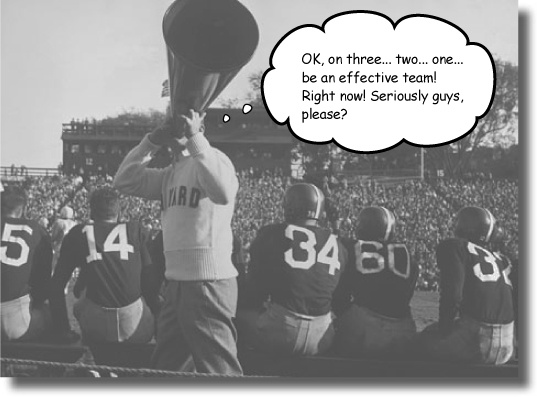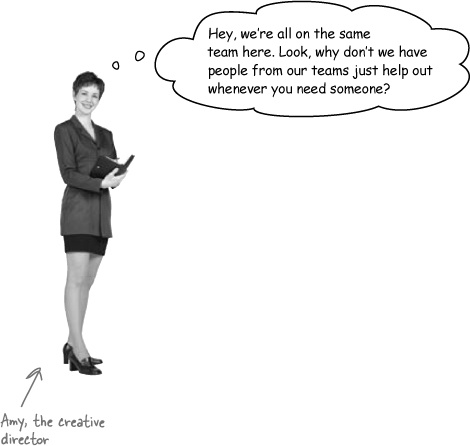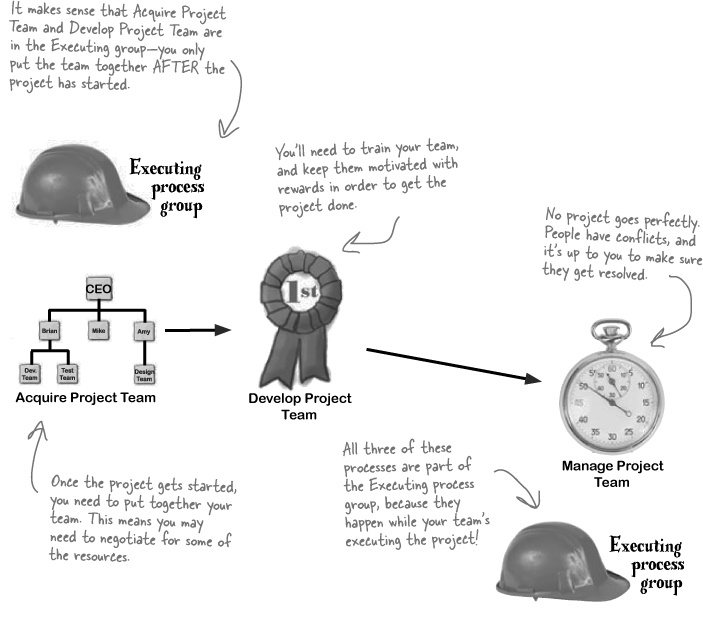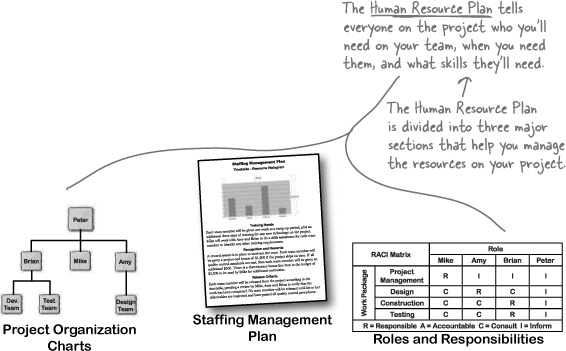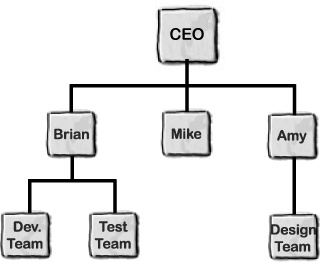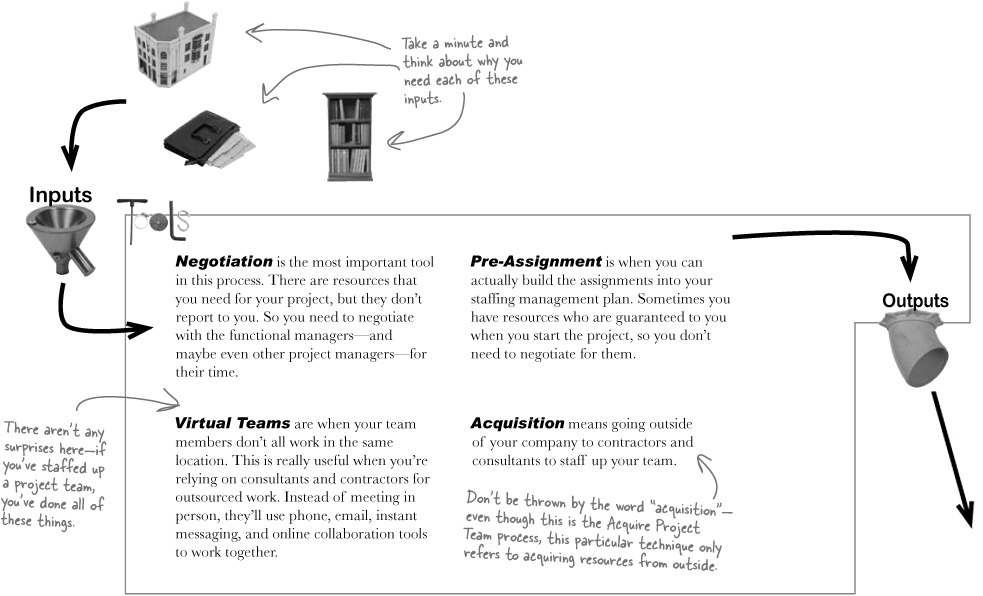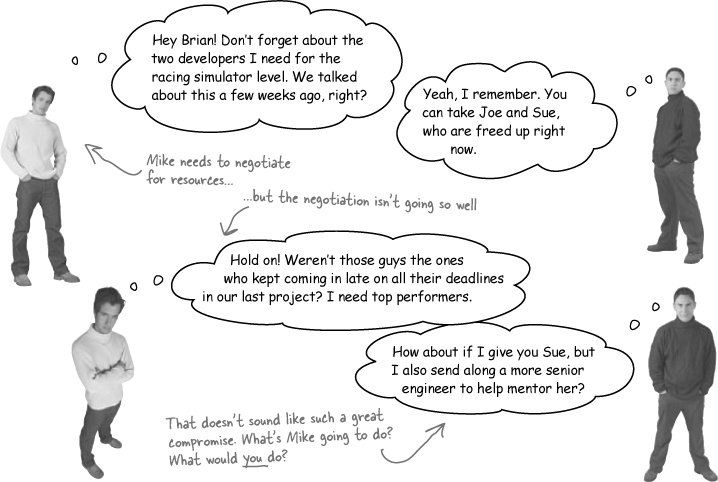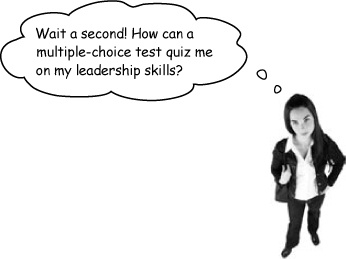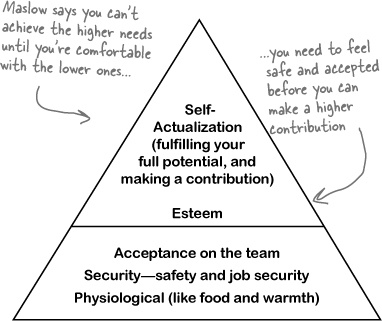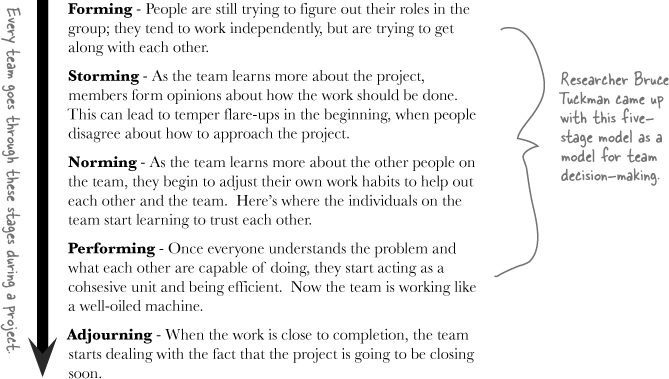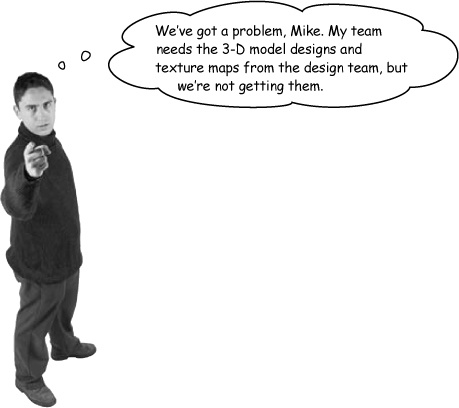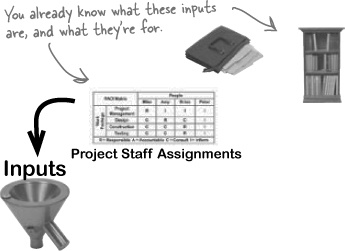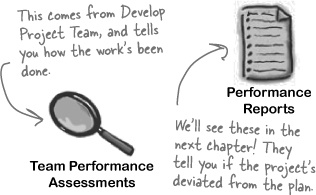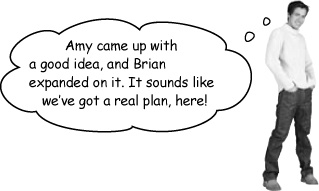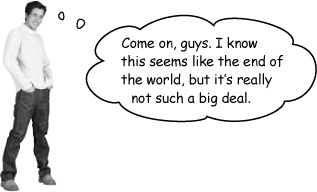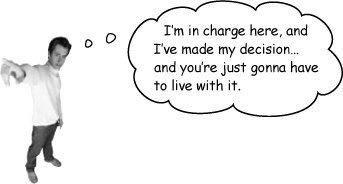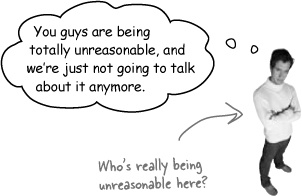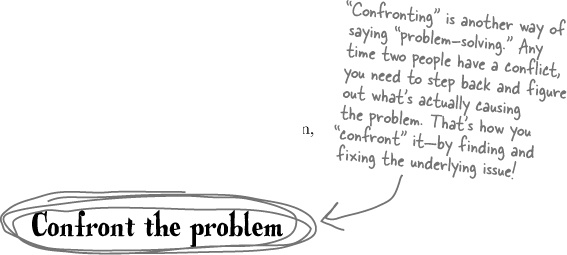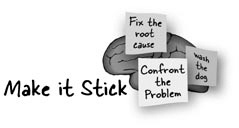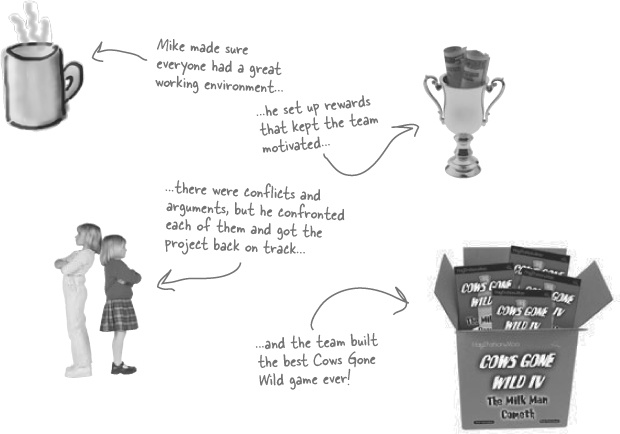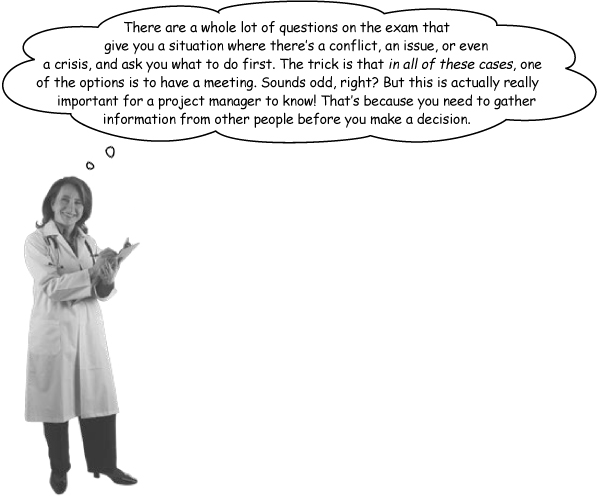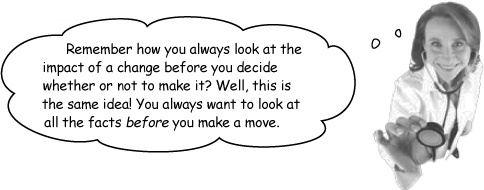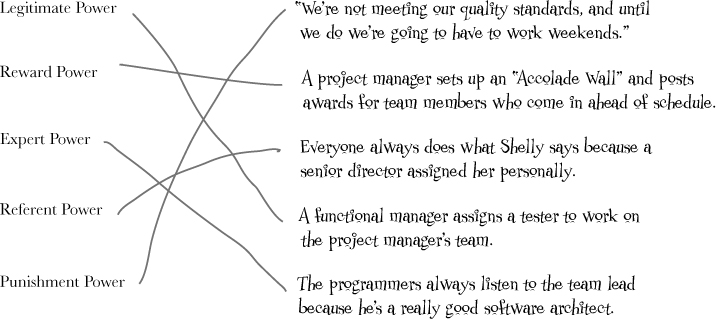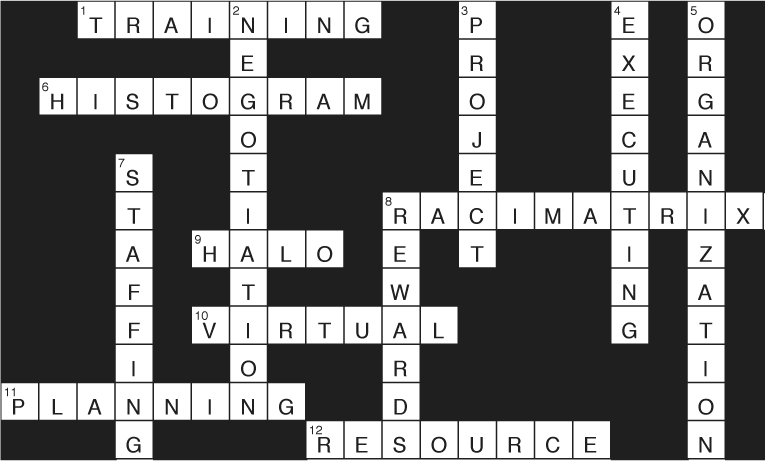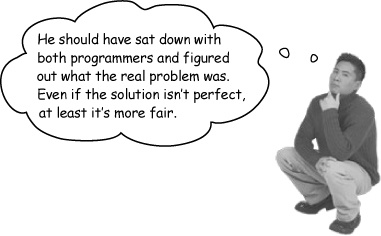Chapter 9. Human resource management: Getting the team together
Behind every successful project is a great team. So how do you make sure that you get—and keep—the best possible team for your project? You need to plan carefully, set up a good working environment, and negotiate for the best people you can find. But it’s not enough to put a good team together... If you want your project to go well, you’ve got to keep the team motivated and deal with any conflicts that happen along the way. Human resource management gives you the tools you need to get the best team for the job and lead them through a successful project.
Mike needs a new team
Cows Gone Wild III was a huge success! But now the Ranch Hand Games team is gearing up for their next big hit. How are things shaping up?
Cubicle conversation
Brian: Yeah, there’s no reason you need our resources dedicated to your project. We can get multiple projects done that way.
Mike: Come on, guys. You don’t really think that’s gonna work, do you?
Amy: Sure, why not?
Mike: We can’t just staff up as we go; that’s going to cause huge problems.
Brian: You’re overreacting, Mike. Look, I’m a team player, and I want to get the project done. You just tell me when you need someone off my team, and I’ll make sure you’ve got the developers and testers you need. What’s wrong with that?
Mike: Okay, so what if I need three developers starting tomorrow for the next two weeks. Can you do that?
Brian: Well, no, I’ve got a deadline on Friday. It’ll have to wait until next Monday. But that’s just a couple of days.
Mike: See, that’s what I’m talking about! A few days here, a few days there... if we have to wait a few days every time the team needs someone, we’ll totally blow the schedule.
Get your team together and keep them moving
You want to stay in control of your project team, right? But when you work in a matrixed organization, your team members don’t directly report to you. So how do you make sure you get the best people, and keep them motivated and productive? That’s what the four processes in Human Resource Management are for: guiding you through all the things you need to do to make sure you get everyone for your project when you need them.
Note
A lot of the stuff in this chapter applies mostly to matrixed organizations... but you’ll still find it really useful, even if you don’t work in a matrixed company!
In the Develop Human Resource Plan process, you plan out exactly which resources you’ll need, what their roles and responsibilities are, and how you’ll train your team and make sure they stay motivated.
Figure out who you need on your team
Project teams don’t just assemble themselves spontaneously! It takes a lot of planning and guidance to get a team together, and that’s the idea behind the Develop Human Resource Plan process. Remember, in a matrixed organization your team doesn’t report directly to the project manager. You need to work with the functional managers to get you the team members that you need for your project... which means there’s a lot of information that you need to give to everyone so they know exactly who you need for your team.
You need two charts because you have two “organizations.”
One organization is the whole company—along with any subcontractors or consultants you’ve got access to for your project team. The other organization is just the people who are on the team. The team might have people from different groups in your company, and they need to know how they interact. That’s why you create a chart just for the team.
Note
Some people will bring in a consultant or expert to manage or lead part of the team. Make sure the project’s org chart shows that relationship, even if it’s not part of the company!
The Project Organization Chart shows how your team members relate with each other.
This might include people or relationships that may not necessarily show up on a company organization chart. If you’ve got a team built from multiple consultants and subcontractors, this chart will be the only place where everyone is listed at once.
Roles and Responsibilities show who’s responsible for what.
It’s really common to see the roles and responsibilities for a project written out as a RACI matrix, which is just a table that lists the role or people on the top; the specific activities, work, or responsibilities down the side; and indicates the level of responsibility that each person or role has for each of the activities or responsibilities. (RACI stands for “Responsible, Accountable, Consulted, and Informed.”)
The staffing management plan
An important component of the Human Resource Plan is the Staffing Management Plan. It tells you everything that you need in order to build your team, keep them motivated, and manage them to resolve conflicts and get the work done.
Everything you do with your team—acquiring them, developing them, and managing them—depends on a good Staffing Management Plan.
Get the team together
Your Human Resource Plan is in place, your project is ready to roll, and now it’s time to begin the actual project work! You need your team, and the way you bring them on board is the Acquire Project Team process.
This is where you negotiate with functional managers for your project team members. You need the right people for the project, and you’ve done all the prep work to figure out who you need and when you need them. So now it’s time to go get your team!
Cubicle conversation
Amy: I haven’t noticed anything. What’s up?
Mike: Well, maybe it’s nothing, but a couple of the design team members have been missing some deadlines. Nothing major, but it’s starting to concern me.
Amy: Well, okay. I can keep an eye on them.
Mike: That’s not all. One of them hasn’t been replying to emails at all, and another scheduled a vacation right in the middle of a huge deadline week. I think we may have a real motivation problem.
Amy: You’re right, that sounds pretty bad. What can I do about it?
Mike: Well, I built a discretionary bonus budget into the plan.
Amy: Right, that $2,500. But should we really be talking about giving bonuses? I thought these were underperformers. Shouldn’t we only reward good behavior?
Mike: Well, right, but if we tie the bonus to meeting an aggressive deadline or high quality standards, it might help get them energized again.
Amy: We can give it a shot, but I’m skeptical.
Develop your project team
The Develop Project Team process is the most important one in Human Resource Management. It’s the one where you make sure your team is motivated and well-managed—and those are some of the most important things that project managers do! You do it throughout the entire Executing phase of the project, because you need to keep your team moving towards the goal.
Note
Get the team involved in planning—the more they feel like they’re in control, the better they feel about the project!
Motivation | Management | ||
One of your most important jobs as project manager is keeping the team motivated and constantly monitoring them to make sure they stay motivated. | When the project is being planned, you’re directing everything—but by the time it’s executing, the project manager is more of a coach and a facilitator. | ||
A really effective way to motivate your team is to set up a reward system. But make sure that they understand exactly what they’re being rewarded for—and it MUST be fair, or it could backfire! | That’s why it’s really important for a project manager to have “soft skills”—you need to really understand what makes your team members tick, and help with their problems. | ||
Training is another great way to keep a team motivated. When people feel that they’re growing professionally, they stay more involved and get more excited by their work. | A really good way to make sure that your project team sticks together is to establish ground rules for your project, which set a standard for how everyone works together. | ||
You develop your project team by keeping them motivated, and you do this all the way through your entire project.
Develop the team with your management skills
How do you keep your team motivated and up and running? With the tools and techniques for Develop Project Team, that’s how. When you’re working with your team, you need to be a leader. That means setting the rules for how people interact with each other, making sure they have the skills they need, setting up a good working environment, and keeping them motivated.
Your interpersonal skills can make a big difference for your team
Knowing all of the tools and techniques in the PMBOK® Guide will help you to know a lot about your project, but the way you help your team to get the job done is just as important as the steps you take to get it done.
Leadership is all about giving the team a goal to shoot for and helping them to see the value in the work they are doing. It’s not enough to have a team know the end product that they’re buiilding; they need to understand the value that that product is going to bring to the company. A project manager needs to constantly remind the team of the vision they’re working toward and make decisions to help keep the team on track toward it.
Note
The team was happy to work on CGW III from the beginning. But when Mike told them that the company saw the game’s success as responsible for 70% of their revenue, it realy showed them how important the work was.
Team-building involves helping your team learn to depend on each other and trust each other. As a project maanger, it’s your job to help the team come to an understanding about how they’ll communicate with each other and stay motivated when things go wrong. If you’re open about your decision-making processes and communicate often about what you’re doing, you can help your team to bond with each other. Some people think of team building as going out for pizzas after work, but it’s more about how you lead, and how you help to create an environment where your team members can trust each other.
Motivation demonstrates to your team the value that the project has for them. It includes making sure that people are compensated and rewarded financially for their work. But that’s not the most the only facet of team motivation that you need to be concerned with. Your team also needs to know how they tasks they’re doing contribute to project success and what’s in it for them. Motivating your team is about helping them to be satisfied with the the job they’re doing, recognizing them when they do a good job, and keeping them challenged with new and different problems.
Communication is a constant concern when you’re leading a team. It’s not enough to make the best decisions to get your project done, you’ve got to make sure that everybody in the team knows why you’re making them and feels like you’re being open and honest about what’s motivating every decision you make. If the people on your team feel like they’re always getting the information they need from you and that they’re never in the dark, they’ll be able to trust you and each other more.
Note
When Mike agreed to consolidate the code reviews for two features into one review, he forgot to tell the team about it. When the first code review was cancelled the team was confused. They thought Mike didn’t care about the quality of the product they were making and the misunderstanding was really hard on them.
Influencing is all about using your relationships with the people on your team to get them to cooperate in making good decisions for the project. When you lead by example, you show your team how you want them to behave by doing it. It may seem subtle, but the way you work as a project manager can set the standard for your teammates. Collaborating with your team on the best way of working through your project is a really effective way of making sure that the team members gel, and know that they can rely on each other.
Note
Mike made sure he came to work early as often as he could. After a while he noticed that everybody on the team was doing the same thing.
Political and Cultural Awareness means knowing the people on your team and understanding their backgrounds. Since projects sometimes span more than one culture, it’s important to take the time to understand the similarities and differences in the working environments across the project team. It’s equally important to communicate with your team members and understand what motivates them.
Decision-Making is how you handle the issues that come up when you’re working through your project. There are a few basic techniques for decision making that you’ll use:
Command - Sometimes, you’ll just make a decision and inform your team about it. You’ll decide and then team will do what you say.
Consultation - Sometimes you’ll talk your decision over with your team and ask for their opinions before you decide.
Consensus - Another way of making decisions is to talk about a few options with your team and get everybody to agree on one of them before you decide.
Coin Flip - Another way to make a decision is to just randomly choose one of the options.
Negotiation helps people the on your team come to an agreement about how to work together. It’s important when your negotiating to listen to both parties in negotiation and to make sure that you make it clear when concessions are made. That should everyone see both sides of the issue and know that you’re negotiating a fair resolution to the issue.
Lead the team with your management skills
You’ve seen tools and techniques that help you set up a great environment for your team to succeed, but you need more than that to get them through a tough project. You need leadership skills, those “soft skills” you use to influence your team and keep them directed toward the project’s goals.
Note
You use leadership skills throughout the entire project! But they’re most important in Develop Project Team because that’s where you lead your team through their work.
You’re right, it can’t. What the PMP® exam can quiz you on is your knowledge of leadership skills. There’s been a lot of research on how people wield power in companies. The PMP exam concentrates on research done by two social psychology researchers named French and Raven who came up with five different kinds of power that people use to influence others.
The five kinds of power
There are five kinds of power that a project manager typically uses on a project. The first is called legitimate power, which is what you use when you assign work to someone who reports to you.
Note
When you’re someone’s boss, you have legitimate power to tell them what to do. But when you work in a matrixed organization, you don’t have direct reports! So you’ll need to use the other kinds of power to influence your team.
Reward power is what you have when you can award a bonus or another kind of reward in order to motivate team members. Always make sure that rewards are fair—you don’t want to single out one person who is eligible for a reward without giving others a chance at it! And rewards work best when they’re tied to specific goals or project priorities.
Expert power means that the team respects you for your expertise in a specific area, and gives you credibility because of that. Think about it: a team of programmers is more likely to respect you and do what you ask them to do if they know that you’re an accomplished software engineer!
Note
Making everyone compete for one single reward isn’t fair—it’s actually demotivating to force people to compete for an arbitrary prize.
Referent power means that people admire you, are loyal to you, and want to do what you do because you’re part of the cool crowd. Often, a project manager might wield referent power because he’s trusted by people in authority, and others perceive him as associated with success.
Punishment power is exactly what it sounds like—you correct a team member for poor behavior. Always remember to do this one-on-one and in private! Punishing someone in front of peers or superiors is extremely embarrassing, and will be really counterproductive.
Motivate your team
No matter how good your “soft skills” are, if your team has a lousy work environment, they’re going to have a hard time getting the project done. Luckily, there’s been research done over the years to figure out exactly what makes a good working environment. For the PMP exam, you’ll be expected to be familiar with the most popular theories of motivation and organization.
Maslow’s Hierarchy of Needs says that people have needs, and until the lower ones are satisfied they won’t even begin to think about the higher ones.
Note
You might see this in a question about “Maslow’s theory,” or it might show on the exam as “Hierarchy of Needs” or “Maslow’s Hierarchy.”
Herzberg’s Motivation-Hygiene Theory
Note
A “hygiene factor” is something like a paycheck or status—stuff that people need in order to do the job. If people don’t have this stuff, it’s really hard to motivate them!
Sure, you love being a project manager. But would you do the job if you weren’t getting a paycheck? Of course not!
What Herzberg figured out was that you need things like good working conditions, a satisfying personal life, and good relations with your boss and coworkers—stuff he called “hygiene factors.” They don’t motivate you, but you need them before you can be motivated. Until you have them, you don’t really care about “motivation factors” like achievement, recognition, personal growth, or career advancement.
McGregor’s Theory X and Theory Y
McGregor tells us that there are two kinds of managers: ones who assume that everyone on the team is selfish and unmotivated, and ones who trust their team to do a good job. He calls the kind of manager who distrusts the team a “Theory X” manager, and the kind who trusts them a “Theory Y” manager. You could get exam questions where the answer could be “Theory X” or “Theory Y”—or both!
Note
A Theory X manager will micromanage the team, looking over everyone’s shoulder all the time and making them feel like they aren’t trusted.
It’s much better—and easier—to be a Theory Y manager. If you trust the team to do their jobs, they won’t let you down!
Expectancy Theory says that you need to give people an expectation of a reward in order to motivate them—but this only works if that award is achievable. If everyone knows the award is either worthless or impossible to achieve, it will actually demotivate them!
McClelland’s Achievement Theory says that people need achievement, power, and affiliation to be motivated. Achievement is when someone performs well and is recognized for it. Power means he or she has a lot of control or influence in the company. And someone feels a strong sense of affiliation from being a part of a working team and having good relationships with coworkers.
Stages of team development
There’s a process for a team to get from a group of strangers to a group that creates something good together, that’s what the stages of team development are all about.
Although this is the normal progression, it’s possible that the team can get stuck in any one of the stages. One big contribution you can make, as the Project Manager, is to help the team get through the initial Storming phase and into Norming and Performing. It’s important to keep in mind that people have a tough time creating team bonds initially, and to try to use your soft skills to help the team to progress through the stages quickly.
How’s the team doing?
There are two outputs of Develop Project Team. One is the Team Performance Assessment. Developing the project team means working with them to keep everyone motivated, and training them to improve their skills. The other is updates to your company’s Enterprise Environmental Factors, to update your company’s personnel records.
Cubicle conversation
Amy: Look, we’ve been over this, Brian. My team is working on level design, and that’s the priority right now.
Brian: Mike, is that true?
Mike: I checked the schedule, and all three of those things are part of the current activity. It’s not really clear which one of them is the priority.
Brian: Look, my team will be halted if we don’t get those models and textures.
Amy: Come on, Brian. You guys have a whole bunch of unit tests that you can write, and I know you’re a week behind on code reviews. Can’t you just work on those in the meantime?
Brian: My team’s been reviewing code for two weeks now. They need a break!
Amy: Aha! So it’s not really that you’re going to fall behind if you don’t get the textures immediately.
Brian: Well, no, but I’ll be dealing with a team that has motivation problems. And I’m the one who has to clean up that mess!
Mike: OK, hold on, guys. Let’s see if we can work this out.
Amy: I don’t see what there is to work out. He’s being unreasonable.
Managing your team means solving problems
Wouldn’t it be great if your team members never had any conflicts? Well, we all know that conflicts are a fact of life in any project. A good project manager knows how to handle conflicts so they don’t delay or damage the project. And that’s what the Manage Project Team process is about.
Conflict management up close
It’s probably no surprise that over half of conflicts come from priorities, schedules, and people. That’s why so many of the processes you’re learning about are focused on preventing conflicts. Ground rules, good planning practices, and pretty much anything that has to do with communication are all there to prevent the most common reasons that conflicts happen.
Some of the common reasons that conflicts happen
Resources are scarce—that’s why you have to negotiate for them. Have you ever been in a situation where there’s a “good” conference room, or top-performing team member, or even that photocopy machine that always seems to be in use? Well, that’s a scarce resource. No wonder resources cause so many conflicts.
Priorities mean one project or person is more important than another, and gets more budget, resources, time, prestige, or other perks. If the company’s priorities aren’t crystal clear, then conflicts are definitely going to happen.
Schedules decide who gets what, when. Have you ever had a client, sponsor, or stakeholder get upset because your project won’t come in as early as he or she wanted it to? Then you’ve had a conflict over schedules.
Over half of all conflicts are caused by resources, priorities, and schedules.
Personalities are always clashing. Sometimes two people just don’t get along, and you’re going to have to find a way to make them work together in order to get your project done.
Cost disagreements seem to come up a lot, especially where contracts are involved. Even when the price is agreed upon up front, buyer’s remorse will set in, and it will lead to issues.
Technical opinions are definitely a reason that conflicts happen, because it’s really hard to get an expert to change his mind... so when two of them disagree, watch out!
How to resolve a conflict
When you’re managing a project, you depend on people to get the work done. But when they have any sort of conflict, your project can grind to a halt... and you’re the one who has to face the music when it causes delays and costs money! Since you’re on the hook when a conflict threatens your project, you’re the one who has to resolve it. Luckily, there are some techniques for getting your conflicts resolved.
The best way to resolve a conflict is to confront the problem: do your research, figure out what’s behind it, and fix the root cause.
Confronting—or problem-solving—is the most effective way to resolve a conflict. When you confront the source of the conflict head-on and work with everyone to find a solution that actually fixes the reason that conflicts happen, then the problem is most likely to go away and never come back!
Compromise sounds good, doesn’t it? But hold on a second—when two people compromise, it means that each person gives up something. That’s why a lot of people call a compromise a “lose-lose” solution.
Note
You should always try to confront the problem first—you should only forge a compromise after you’ve tried every possible way to solve the real problem.
Collaborating means working with other people to make sure that their viewpoints and perspectives are taken into acount. It’s a great way to get a real commitment from everyone.
Smoothing is what you’re doing when you try to play down the problem and make it seem like it’s not so bad. It’s a temporary solution, but sometimes you need to do it to keep tempers from flaring and give people some space to step back and really figure out what’s going on.
Forcing means putting your foot down and making a decision. One person wins, one person loses, and that’s the end of that.
Withdrawal doesn’t do much good for anyone. It’s when people get so frustrated, angry, or disgusted that they just walk away from the argument. It’s almost always counterproductive. If someone withdraws from a problem before it’s resolved, it won’t go away—and your project will suffer.
No! Confrontation is just another name for problem-solving, because you solve a problem by confronting it head-on, doing your research, and fixing whatever is causing it. If you always remember to:
...it will really help you through a bunch of questions on the exam!
Try to avoid using punishment. When you do have to punish someone, make sure to do it in private, and not in front of peers or other managers.
The Cows Gone Wild IV team ROCKS!
The odds were against Mike—he had to fight for a whole new team, keep them motivated, and solve some pretty serious problems. But he followed his plan, got a great team together, kept them on track, and got the product out the door!
Question Clinic: The “Have-A-Meeting” Question
Join the Head First PMP community at http://www.headfirstlabs.com/PMP You can add your Head Libs answer, and see what Head Libs other project managers came up with!

